![Placido Domingo as Gianni Schicchi, with Philip Cokorinos as Betto di Signa and Andriana Chuchman as Lauretta. [Photo: Craig T. Mathew / LA Opera]](http://www.operatoday.com/GS-PD-15232-144.png)
29 Sep 2015
Verismo Double Header in Los Angeles
LA Opera got its season off to an auspicious beginning with starry revivals of Gianni Schicchi and Pagliacci.
English Touring Opera are delighted to announce a season of lyric monodramas to tour nationally from October to December. The season features music for solo singer and piano by Argento, Britten, Tippett and Shostakovich with a bold and inventive approach to making opera during social distancing.
This tenth of ten Live from London concerts was in fact a recorded live performance from California. It was no less enjoyable for that, and it was also uplifting to learn that this wasn’t in fact the ‘last’ LfL event that we will be able to enjoy, courtesy of VOCES8 and their fellow vocal ensembles (more below …).
Ever since Wigmore Hall announced their superb series of autumn concerts, all streamed live and available free of charge, I’d been looking forward to this song recital by Ian Bostridge and Imogen Cooper.
Although Stile Antico’s programme article for their Live from London recital introduced their selection from the many treasures of the English Renaissance in the context of the theological debates and upheavals of the Tudor and Elizabethan years, their performance was more evocative of private chamber music than of public liturgy.
Evidently, face masks don’t stifle appreciative “Bravo!”s. And, reducing audience numbers doesn’t lower the volume of such acclamations. For, the audience at Wigmore Hall gave soprano Elizabeth Llewellyn and pianist Simon Lepper a greatly deserved warm reception and hearty response following this lunchtime recital of late-Romantic song.
For this week’s Live from London vocal recital we moved from the home of VOCES8, St Anne and St Agnes in the City of London, to Kings Place, where The Sixteen - who have been associate artists at the venue for some time - presented a programme of music and words bound together by the theme of ‘reflection’.
'Such is your divine Disposation that both you excellently understand, and royally entertaine the Exercise of Musicke.’
‘And there was war in heaven: Michael and his angels fought against the dragon; and the dragon fought and his angels, And prevailed not; neither was their place found any more in heaven … that old serpent … Satan, which deceiveth the whole world: he was cast out into the earth, and his angels were cast out with him.’
There was never any doubt that the fifth of the twelve Met Stars Live in Concert broadcasts was going to be a palpably intense and vivid event, as well as a musically stunning and theatrically enervating experience.
‘Love’ was the theme for this Live from London performance by Apollo5. Given the complexity and diversity of that human emotion, and Apollo5’s reputation for versatility and diverse repertoire, ranging from Renaissance choral music to jazz, from contemporary classical works to popular song, it was no surprise that their programme spanned 500 years and several musical styles.
The Academy of St Martin in the Fields have titled their autumn series of eight concerts - which are taking place at 5pm and 7.30pm on two Saturdays each month at their home venue in Trafalgar Square, and being filmed for streaming the following Thursday - ‘re:connect’.
The London Symphony Orchestra opened their Autumn 2020 season with a homage to Oliver Knussen, who died at the age of 66 in July 2018. The programme traced a national musical lineage through the twentieth century, from Britten to Knussen, on to Mark-Anthony Turnage, and entwining the LSO and Rattle too.
With the Live from London digital vocal festival entering the second half of the series, the festival’s host, VOCES8, returned to their home at St Annes and St Agnes in the City of London to present a sequence of ‘Choral Dances’ - vocal music inspired by dance, embracing diverse genres from the Renaissance madrigal to swing jazz.
Just a few unison string wriggles from the opening of Mozart’s overture to Le nozze di Figaro are enough to make any opera-lover perch on the edge of their seat, in excited anticipation of the drama in music to come, so there could be no other curtain-raiser for this Gala Concert at the Royal Opera House, the latest instalment from ‘their House’ to ‘our houses’.
"Before the ending of the day, creator of all things, we pray that, with your accustomed mercy, you may watch over us."
The doors at The Metropolitan Opera will not open to live audiences until 2021 at the earliest, and the likelihood of normal operatic life resuming in cities around the world looks but a distant dream at present. But, while we may not be invited from our homes into the opera house for some time yet, with its free daily screenings of past productions and its pay-per-view Met Stars Live in Concert series, the Met continues to bring opera into our homes.
Music-making at this year’s Grange Festival Opera may have fallen silent in June and July, but the country house and extensive grounds of The Grange provided an ideal setting for a weekend of twelve specially conceived ‘promenade’ performances encompassing music and dance.
There’s a “slide of harmony” and “all the bones leave your body at that moment and you collapse to the floor, it’s so extraordinary.”
“Music for a while, shall all your cares beguile.”
The hum of bees rising from myriad scented blooms; gentle strains of birdsong; the cheerful chatter of picnickers beside a still lake; decorous thwacks of leather on willow; song and music floating through the warm evening air.
![Placido Domingo as Gianni Schicchi, with Philip Cokorinos as Betto di Signa and Andriana Chuchman as Lauretta. [Photo: Craig T. Mathew / LA Opera]](http://www.operatoday.com/GS-PD-15232-144.png)
LA Opera got its season off to an auspicious beginning with starry revivals of Gianni Schicchi and Pagliacci.
Director Woody Allen has devised a wonderfully dark comedic point of view for the Puccini that began the night. Mr. Allen gets us in a laughing mood by preceding the opera proper with a film clip, rolling production credits for a 50’s black and white movie, which playfully (and shamelessly) incorporate well-known Italian foods and phrases.
When the curtain rises, it reveals a marvel of a design that carries on the film noir theme, with all elements in shades of black, white, and gray, mixed with a few earth colors. Santo Loquasto’s imposing, sprawling set design features a wrought iron spiral staircase to a balcony level, a kitchen, a sitting room, and of course, as well as the requisite bed-with-a-corpse. Mr. Loquasto’s equally effective costumes were by turns characterful, sleek, sexy, and all perfectly designed to enhance the personality of the character. York Kennedy’s moody lighting design completed a “look” that could be somewhat sinister one moment and wittily playful the next.
The show has been expertly staged by Kathleen Smith Belcher with some contemporary inventions that play against expectations. Lauretta is not the usual dutiful daughter but rather a sexed up vamp who brandishes a knife before daddy forcibly disarms her. The knife shows up in another surprise moment that was perhaps not Puccini’s intention, but it sure created a memorably different ending.
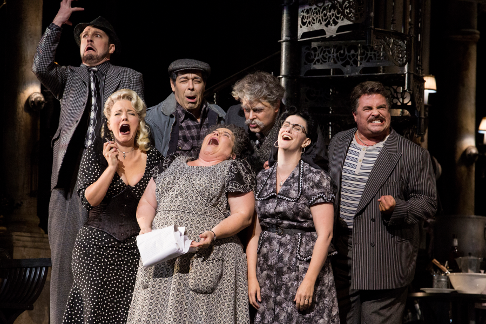 Left to right: Liam Bonner as Marco, Peabody Southwell as La Ciesca, Philip Cokorinos as Betto di Signa, Meredith Arwady as Zita, Craig Colclough as Simone, Stacy Tappan as Nella and Greg Fedderly as Gherardo.
Left to right: Liam Bonner as Marco, Peabody Southwell as La Ciesca, Philip Cokorinos as Betto di Signa, Meredith Arwady as Zita, Craig Colclough as Simone, Stacy Tappan as Nella and Greg Fedderly as Gherardo.
The bickering, calculating relatives were all well drawn, tightly focused, and commendably specific. Blocking was neatly motivated, character relationships were clear, and fluid stage pictures provided a satisfying visual realization. The invention of propping up dead Buoso outside the door as a sleeping beggar (into whose cup visitors plunked coins) was fresh and clever. I was less sure about Lauretta and Rinuccio’s overt sexual behavior, especially their going up to the balcony to disappear on the floor (shagging?) at the end. It was not only untrue to the parameters of 1950’s film concept, but deprived the pair of the sweetness that balances the others’ comic malice. Still, Woody’s concept pleased the capacity audience, and was (mostly) consistent in its commitment.
The strong cast was evenly matched and completely immersed in effective ensemble playing. Each took focus when it was their moment, and deferred when it was not. Meredith Arwady seems to get better and better with my every encounter, which is to say, her solid contralto is as good as it gets. Her steely, imperious Zita ruled the roost, and she had many amusing moments as she cooked in the kitchen almost throughout. Andriana Chuchman was a striking Lauretta, although her poised, limpid singing of “O mio babbino caro” was so lovely it seemed a bit at odds with the she-devil impersonation the director gave her. Sweet-voiced tenor Arturo Chacón-Cruz was boyishly appealing and wonderfully secure. When he started Mr. Chacón-Cruz was a mite underpowered but he grew in stature as the evening progressed, morphing into a heartfelt performance that was marked by warmth of tone and fine musicality. Liam Bonner and Peabody Southwell made for an unusually frisky Marco and La Ciesca, respectively, he singing with burnished tone and she zinging her lines out there with a ripe, round soprano. Greg Fedderly has developed into a fine character tenor, and he lavished Gherardo with pointed, ringing phrases. Stacy Tappan’s delightful Nella was clear-voiced and distinctive. Craig Colclough’s blustery Simone was sung with great gusto, and Philip Cokorinos made every moment count as he put his rolling bass to full effect as a hang-dog Betto di Signa. Young Isaiah Morgan was an audience favorite as the lad Gherardino, whether belting his lines securely, or getting belted around by his rather ‘old school’ Italian parents.
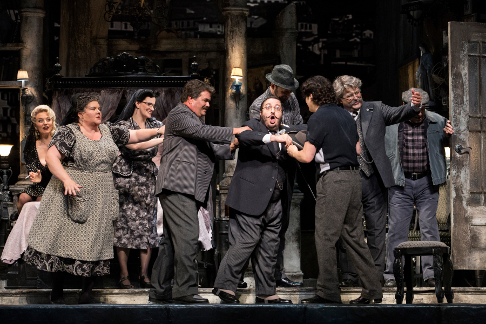 E. Scott Levin as Maestro Spinellocio (center, facing front) with the cast of Gianni Schicchi.
E. Scott Levin as Maestro Spinellocio (center, facing front) with the cast of Gianni Schicchi.
E. Scott Levin was a daffily doddering Maestro Spinelloccio, sporting a lively baritone deployed with sharp comic timing. Former Young Artists Daniel Armstrong was entertaining as a blind “witness” Pinellino, and intoned his few lines with a smooth baritone. Gabriel Varmvulescu chimed in effectively as Guccio, and best of all, firm-voiced bass (and Young Artist) Kihun Yoon was an inspired Notary. In the pit, Grant Gershon kept the evening percolating with a reading that found just the right balance of forward motion, comic accents, and veristic elasticity. The orchestra played with an assured panache.
One common denominator between the evening’s two one-act operas is the decidedly “uncommon” Plácido Domingo. Mr. Domingo is a remarkable phenomenon, like no one else in the entire history of the operatic art form. In addition to his celebrated career as one of the greatest tenors in history, with countless “firsts” and “mosts” and “bests” in its footnotes, the impresario heads LA Opera itself, conducts performances with regularity, operates one of the world’s most prestigious singing contests, and oh yes, is still singing opera at 74 years young in the baritone “Fach.”
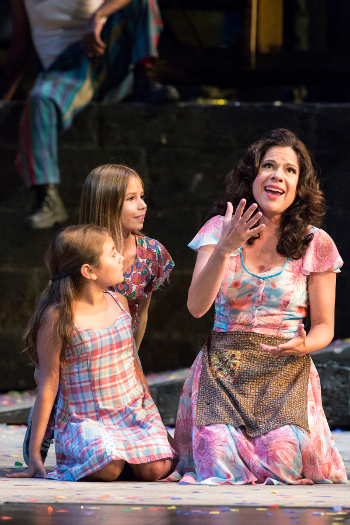 Ana Maria Martinez (right) as Nedda
Ana Maria Martinez (right) as Nedda
Small wonder that the adoring public cheers his every appearance — first as the title role in Schicchi and then as the Maestro in the pit for Pagliacci. Plácido Domingo is an unparalleled factotum, the likes of which has never been seen before and will surely never be seen again. His local public knows that he IS Los Angeles Opera, and they rightly celebrate him accordingly. His is a remarkable package of achievements including a remarkable career as one of the finest singers of his generation.
As Schicchi, he sang intelligently, musically, and with good comic delivery. He did the bass-baritone role very competently, but . . .as a tenor with a decent baritonal tint to his core voice. Did he eclipse (or even challenge) the likes of a Bryn or Sherrill or Cornell in the part? No. On the podium, Maestro Domingo was clean and well organized, and he kept things moving along with good rhythmic pulse. But there were subtle occasions when he seemed out of touch with his Canio, perhaps helming certain phrases as he used to sing them rather than as a collaborative effort with the artist on stage. Did he challenge the conducting accomplishments of a Jimmy or Riccardo or Lenny? No.
And therein lies a conundrum. While his other achievements are uniquely remarkable, his “baritone” and his conducting, while pleasantly agreeable, are not in the same league as the rest of his legend. But only he can decide when being a living legend is simply enough, especially when his public keeps coming back for more.
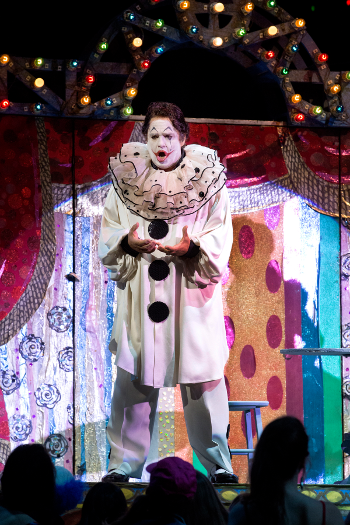 Marco Berti as Canio
Marco Berti as Canio
Pagliacci was an over-the-top, eye-filling Franco Zeffirelli production that rivaled Cecil B. DeMille for its Hollywood overstatement. It was nothing if not colorful, bustling, and crowded with mini-dramas and character details that extended down to the last chorister. The trouble is, while Mr. DeMille could focus in on the key characters and isolate important moments with a close-up, stage director Stefano Trespidi could not figure out how to direct our attention to the important players at key exchanges. His creed seems to be: “Nothing exceeds like excess.”
Even with the “performance stage” erected stage right, and the thrice familiar drama being played out upon it, there was so much bustle from extraneous street performers that the visual effect was distracting at best, and damaging at worst. Ironically, the gyrating, frenetic extras were urging the “spectators” to look at the stage all the while they completely stole focus from our doing just that.
Ana Maria Martinez was an ideal Nedda, her urgent soprano showing real urgency and passion. Full-bodied in all registers, Ms. Martinez especially shone above the staff where her gleaming delivery gave much pleasure. Her “Stridono lassù" was a lovely outpouring of longing and lush tone. Too bad then that she was largely upstaged by milling town folk, and had to hold hands with, and sing her thoughts to a group of school girls.
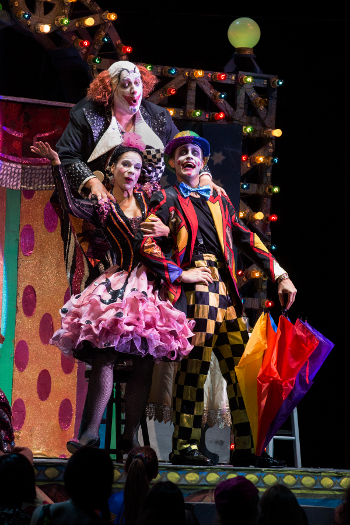 George Gagnidze (top) as Tonio, with Ana Maria Martinez as Nedda and Brenton Ryan as Beppe
George Gagnidze (top) as Tonio, with Ana Maria Martinez as Nedda and Brenton Ryan as Beppe
George Gagnidze was in fine form as Tonio, firm of voice, and unctuous of delivery. His prologue was commanding if a bit calculated. In the opera proper Mr. Gagnidze found more spontaneity and color in the more conniving and lecherous statements of his character. Liam Bonner was all that could be desired as Silvio, tall and handsome, and possessed of a mellifluous lyric baritone with persuasive warmth.
Young Artist Brenton Ryan’s Beppe found his vocal stride in a beautifully judged serenade. Earlier, he took time to warm to his task and was a little light in vocal presence.
Of course, Pagliacci is nothing without a potent Canio, and LAO was very fortunate in its leading man Marco Berti. Mr. Berti knows every nuance in this iconic role and his substantial tenor has an ideal heft and ring. If the tenor sometimes pushes his pitch sharp, and sometimes overdoes sobbing portamento effects, he nevertheless captured the empathy of the audience. “Vesti la giubba” was the rich emotional journey it need to be, and Marco knew just how to make each syllable count, prompting enthusiastic audience response. But did they need to beak the spellbinding illusion Berti created by giving him an out-of-character bow in front of the curtain right after it?
But really, that sums up this Pagliacci: satisfying singing that succeeded in spite of a whole list of questionable staging choices that kept yanking us away from the honest emotion and the tragic interaction of some highly gifted performers.
James Sohre
Casts and production information:
Gianni Schicchi:
Gianni Schicchi: Plácido Domingo; Lauretta: Andriana Chuchman; Zita: Meredith Arwady; Rinuccio: Arturo Chacón-Cruz; Gherardo: Greg Fedderly; Nella: Stacy Tappan; Simone: Craig Colclough; Betto di Signa: Philip Cokorinos; Marco: Liam Bonner; La Ciesca: Peabody Southwell; Maestro Spinelloccio: E. Scott Levin; Ser Amantio di Nicolao (Notary): Kihun Yoon; Gherardino: Isaiah Morgan; Pinellino: Daniel Armstrong; Guccio: Gabriel Vamvulescu; Conductor: Grant Gershon; Director: Woody Allen (staged by Kathleen Smith Belcher); Set and Costume Design: Santo Loquasto; Lighting Design: York Kennedy
Pagliacci:
Canio: Marco Berti; Nedda: Ana Maria Martinez; Tonio: George Gagnidze; Silvio: Liam Bonner; Beppe: Brenton Ryan; First Man: Arnold Geis; Second Man: Steven Pence; Conductor: Plácido Domingo; Director and Set Designer: Franco Zeffirelli (staged by Stefano Trespidi); Costume Design: Raimonda Gaetani; Lighting Design: York Kennedy; Chorus Director: Grant Gershon; Children’s Chorus Director: Anne Tomlinson